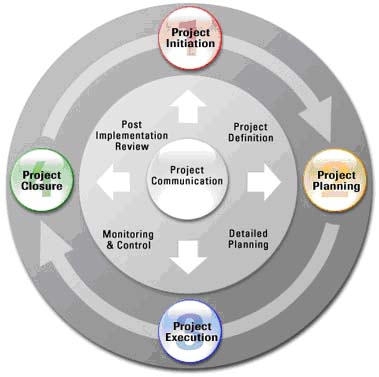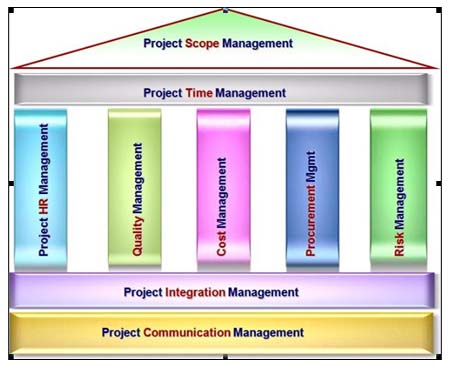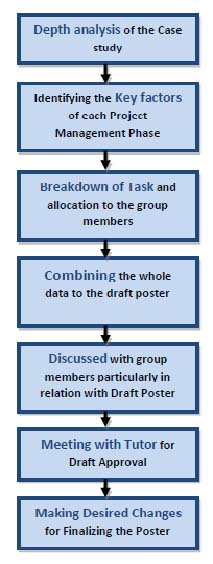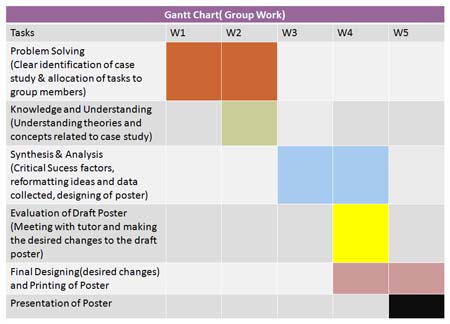Project Management Case Studies
1. Introduction
This individual reflection report will highlight the key lessons learnt during my experience of working in a group during the Project Management Case Studies module. It will also reflect on various project management attributes that I came across while identifying my case study, lessons learnt from visitor speakers and applying various project management models, theories and concepts in different cases. It will describe the allocation of the tasks among the group members, personal behaviour, team dynamics and understanding, synthesis and analysis of data in relation with case studies allocated to our group and in various group tasks held during sessions in depth. Moreover, it also describes the critical incidents that helped in the preparation of a good poster and finally evaluates the whole project from personal and group point of view.
2. Group tasks
The class was divided into groups of three to four members. We were asked to work in groups because, in the corporate world and also as a project manager, it is essential to have experience of working in a group. This was provided by the basics of this module. My group had four members in it. The name of my group was ‘Innovations’. From initial stage we decided that we would distribute the work of every task we received among us so that each member could contribute equally to the tasks. I initiated and acted as leader in the group. The group members accepted me as a leader because, knowing me from before, they knew that I would be a better leader than other members in the group. As I had also been the leader of my group in Project Management Theory and Practice module the previous semester, I was confident enough to take on the leadership and knew how I could facilitate and guide work on the tasks which would be allocated to us. We had been given various group tasks, such as a London Ambulance case study, a group task of Logica, and various other case studies such as Project Phoenix on which our group had to present a poster. I know that communication between group members is the most important thing, and we hence all used to discuss every task given and also give each other suggestions. As some of the group members were working part time, they were not able to contribute fully to the group work and hence others, including myself, helped them to complete the tasks successfully. Motivation is another important factor in a group’s success, and hence all the members in the group constantly motivated each other and also appreciated each other’s work wherever needed. This helped spread a positive energy among us and made our work better than that of others.
3. Lessons learnt from Case Studies
The first case study given to our group was ‘London Ambulance Service Computer Aided Despatch System’ in which we had to discuss the factors that had led to its failure. We had to discuss the problems during planning, real time problems and major system problems. After discussion, we discovered that it was a failure due to many reasons, primarily lack of communication, poor project management, unrealistic timelines and deadlines, lack of experience and training in staff, absence of crisis management, etc.
Then we were given key points for a project to be successful from Synergy Professional Services. These included customer involvement, agreement on the goals of the project, frequent progress checks and course corrections, a plan that shows overall path and responsibilities, constant and effective communication with everyone, controlled scope and management support.
Thereafter, we were assigned a case study of ‘The Custom Woodworking Company- Woody 2000 Project’, in which we had to discuss certain aspects of project management therein. These included the concept and strategy of the project, its scope, planning, quality, and scheduling, estimating the overall cost of the project, communication, people management, evaluating the progress of the project, monitoring and controlling it, cost control, identifying and managing the risks and finally project close-out. Here we had to present some of the key findings from the questions asked in relation with the case study. In this case study, we learnt that lack of experience can result in the delay of a project and eventually cause it to go over budget. Even internal disputes among team members can lead to miscommunication and delay in a project, and thereby incur several losses in the business. It is also important to keep all records of the work on sheet, with proper times and dates, for future use of that project or that particular organisation.
The final case study for which we had to present a poster was ‘Project Phoenix: Rebuilding and American Landmark’. Different groups were randomly assigned different case studies. Some groups had ‘The Chunnel Project’ as their case study, some had ‘Springfield Interchange Improvement Project’, and the rest had ‘Superconducting Super Collider Project’. Each case study was unique and different from the others. Some projects were total successes, some total failures, and some were a mixture of both. In this final task, all groups had to present a poster documenting the four phases of PMI, and the role of factors such as scope, time, human resources, quality, procurement and risk within each of PMI Project Life-Cycle phase with critical success factors. A detailed explanation of the experience of working in a group while making the poster is also given later in the report.
4. Lessons learnt from Visitor Speakers
We had three visiting speakers, the first of who was Mr. Tom Snelgrove (Chief of Staff) in Atlas (Joining Forces). He explained the mission of his firm and its overall working with regards to staff members and procedure of the work and their partners, which included Fujitsu (Tier 1), EADS and Logica (Tier 2). In his speech he said that the two major factors of governance/corporate governance and stakeholder managementare very important for any project. It is essential to know about the governance of the firm to which the project belongs, to be familiar with all the stakeholders involved and their various levels, which stakeholder holds decision-making authority, and which are stubborn and have to be managed additionally.
Our second visiting speaker was Mr. John Lord, a project manager for launching and opening a venue. From his presentation we learnt that there are three main aspects to a project: completion, launching and opening of the venues, stadia, and indoor arenas. We also learnt that establishing the opening date of the venue can speed up construction work, what the correct time that staff should be appointed for the project to start is, marketing of events, soft openings of venue, administration, returns on investment, quality control, cost estimation, confidence, crisis management, right people with right project management model and guarantee maximum price (GMP) are the most important factors considered being a project manager.
Our final visiting speaker was Professor Vassilis Kostoglou, EU project manager (ECQA Certified). He described a case study on MS-Project and explained how a project can be planned using this software. He also explained how to make a Gantt chart with this software and how to conduct budget estimation of a project. He gave an example of an IT company working on a project for a period of one month. For estimation of the project he considered the various phases/activities involved in it and the relevant staff used in those activities.
5. Theories and concepts used in poster

For making the poster we were asked to implement and analyse the given case study in terms of PMI Project Life-Cycle Phases. As shown in the figure above, according to Project Management Institute there are four main phases of project life-cycle for any project, namely, Project Initiation or Inception, Project Planning or Development, Project Execution or Implementation and Project Closure.
Project Initiation: In this phase the project definition is identified or project proposal is formed. Organisational strategy, scope, project architecture, linkage of projects with other projects, alternate options in case of failure (i.e., crisis management, etc) are the factors which are considered in this phase.
Project Planning: In this phase, detailed planning of the project is carried out. The design which will be used, formulation, engineering, organising, estimating, budgeting, scheduling and formal approach are the aspects considered in this phase.
Project Execution: This is the most important phase in the project life-cycle. In this phase the project is implemented, monitored and controlled. Various attributes such as cost, time, risk, resources, risk and change management, documentation and training are considered in this phase.
Project Closure: This is the last phase in project life-cycle, during which it is discovered whether the project is successful or a failure. Critical success factors are known, and factors such as key lessons learnt, handover, termination or recommendations can also be known. In this phase a post-implementation review of the project is conducted. In some cases, the phases behave as a cycle; this last phase initiates another first phase that takes the form of Project Initiation or linkage with other project.
(Lock, 2009)

Above are the various project management factors which help ensure project success if implemented in the appropriate way. All of these factors were analysed in the case study and presented in the poster by us in the summary of the project. We assessed each factor for each phase in the project life-cycle from 1 to 5, where 1 stands for poor and 5 stands for excellent. Finally, an average of each factor from four phases was calculated, showing which factor was strongest in that case study and giving an indication of whether it was the reason it was a success or failure if applicable. It also, described which phases were managed well and which poorly by the project manager, and hence which phase required improvements in which factor. From the above Figure it can be seen that Scope and Time are the two factors which are considered in initial phases of any project, after which comes HR, quality, cost, procurement, risk (which acts equally in the next phases) and finally integration and communication (Munns & Bjeirmi, 1996; Lewis, 2006).
Factors that can lead to project failure:
If the there are unrealistic deadlines, lack of communication, continuous changes in scope, dependencies of work, insufficient resources or competition for them, lack of team skills, no risk management, non-involvement of end users and customers in the project, unavailability of crisis management plan, or unclear goals and vision, the chances that a project will fail are good. It is very important to consider these factors in order to be a successful project manager (Ford, 2004).
6. Processes involved in and contribution by each group member in Poster Presentation
 Effective delegation of tasks is crucial in performing any group task so that each member has a clear idea of everything before it is initiated. By looking at the diagram one can see that we followed a few simple steps to organise our work more efficiently in order to achieve the desired goal and objective. Firstly, the whole group decided to perform a depth analysis of the case study to become familiar with the whole Project. After depth reading and analysis, each group member tried to identify the key factors of each Project Management Phase. Following this, the whole group decided to design an overview of the poster on paper so that we were able to allocate tasks to various members according to it. Each group member drafted key points on each PMI project life-cycle phase. For example, in the inception phase, one member drafted the key points and actions taken, as happened in development, implementation and close-out phases. Then, we also noted the critical success factors and a summary of the entire case study in the poster, and finally referenced all our work properly at the end. As I am a graphic designer, I asked my group members to allocate the task of design to me so that I could use my skills and help the group to achieve the highest possible score. I used a theme of ‘pentagons’ in the entire poster as our case study was related to ‘Pentagon in U.S.A.’ (i.e., Project Phoenix). I used various software programs to design this poster, including Adobe Acrobat, Adobe Photoshop, Adobe Illustrator and Macromedia Flash. I also inserted various images relevant to the case study and related to Project Management into the poster to make it more attractive and understandable. One of our group members also suggested a wonderful title which helped make our poster different to others. After completion of individual tasks by group members, we discussed amongst ourselves and combined the data on the draft poster. Following this, we had a meeting with the tutor for suggestions and approval of the draft poster. In the meeting with our tutor we were asked to add the key lessons learnt in the poster in relation to the case study in terms of Project Management. After this meeting with the tutor, we made the final modifications suggested by the tutor and also by the group members in order to finalize the poster for printing and presentation. One of the best aspects of this project was that our group did not encounter any conflict while working on the tasks allocated to us. We all co-operated with each other for each and every task, shared our knowledge and understandings and suggested various things related to tasks to each other. Many of the decisions in the group were made mutually but, as mentioned before, as I played the role of leader of the group, a greater contribution was made by me than by any of the others. Other members in group agreed with me as they had trust in me and my work. No one was rude to any group member in any way during the entire task. All of us enjoyed working with each other, and the overall experience was wonderful and the journey was very knowledgeable. The key lessons learnt from this module proved very helpful in this group task and would also be useful in the future in the workplace while working as a project manager or as a team member in any organisation. I think I gave my total input in all the tasks allocated to us in this module but could have done better because, as it is said, a person learns from his experiences.
Effective delegation of tasks is crucial in performing any group task so that each member has a clear idea of everything before it is initiated. By looking at the diagram one can see that we followed a few simple steps to organise our work more efficiently in order to achieve the desired goal and objective. Firstly, the whole group decided to perform a depth analysis of the case study to become familiar with the whole Project. After depth reading and analysis, each group member tried to identify the key factors of each Project Management Phase. Following this, the whole group decided to design an overview of the poster on paper so that we were able to allocate tasks to various members according to it. Each group member drafted key points on each PMI project life-cycle phase. For example, in the inception phase, one member drafted the key points and actions taken, as happened in development, implementation and close-out phases. Then, we also noted the critical success factors and a summary of the entire case study in the poster, and finally referenced all our work properly at the end. As I am a graphic designer, I asked my group members to allocate the task of design to me so that I could use my skills and help the group to achieve the highest possible score. I used a theme of ‘pentagons’ in the entire poster as our case study was related to ‘Pentagon in U.S.A.’ (i.e., Project Phoenix). I used various software programs to design this poster, including Adobe Acrobat, Adobe Photoshop, Adobe Illustrator and Macromedia Flash. I also inserted various images relevant to the case study and related to Project Management into the poster to make it more attractive and understandable. One of our group members also suggested a wonderful title which helped make our poster different to others. After completion of individual tasks by group members, we discussed amongst ourselves and combined the data on the draft poster. Following this, we had a meeting with the tutor for suggestions and approval of the draft poster. In the meeting with our tutor we were asked to add the key lessons learnt in the poster in relation to the case study in terms of Project Management. After this meeting with the tutor, we made the final modifications suggested by the tutor and also by the group members in order to finalize the poster for printing and presentation. One of the best aspects of this project was that our group did not encounter any conflict while working on the tasks allocated to us. We all co-operated with each other for each and every task, shared our knowledge and understandings and suggested various things related to tasks to each other. Many of the decisions in the group were made mutually but, as mentioned before, as I played the role of leader of the group, a greater contribution was made by me than by any of the others. Other members in group agreed with me as they had trust in me and my work. No one was rude to any group member in any way during the entire task. All of us enjoyed working with each other, and the overall experience was wonderful and the journey was very knowledgeable. The key lessons learnt from this module proved very helpful in this group task and would also be useful in the future in the workplace while working as a project manager or as a team member in any organisation. I think I gave my total input in all the tasks allocated to us in this module but could have done better because, as it is said, a person learns from his experiences.
7. Gantt chart for Poster Making and Presentation

A Gantt chart is very useful tool for planning any task or project in ensuring that we manage the available time more efficiently and effectively. When the case study for the poster presentation was given to us, we had five weeks available to complete the task, so we decided to plan the schedule of the task according to the Gantt chart. We had this idea because we had learnt about making Gantt charts in our Project Management Theory and Practice module and, according to us, it would be one of the best ways to implement this concept in our own group task because a theory or concept is useful only if it is implemented correctly (Mantel, Meredith, Shafer & Sutton, 2007).
It is essential to stipulate the time required for each sub-task, and therefore our group decided to allocate more time to the areas which are very complex and crucial. By looking at the Gantt chart, we can see that, for identification and understanding of the entire case study and for allocation of tasks among the group members, we allocated the first two weeks. In the second week, we simultaneously identified the theories and concepts related to case study. In the third and fourth week of the task we performed synthesis and analysis which included data in terms of critical success factors of the case study, designing the poster, and formatting and reformatting of the ideas data to produce a draft poster. At the same time we had a meeting with the tutor for approval and suggestions. We made the requested modifications to the draft poster in the fourth and fifth week and finally submitted the poster for printing. After receiving the printed poster, we had our presentation on the same day.
While performing all the above tasks we also had to manage our daily study routine with other subjects in our MBA course and those in this module too. In the above time period, two visiting speakers came to share their experiences as project managers and taught us the key points for being a successful project manager. We were also given different case studies to work on as a part of the module, and we thus had to cope up with all the tasks simultaneously with the making of the poster. Hence, we were sometimes not able to dedicate all our time to the preparation of this poster, but we nevertheless managed it all in a suitable manner with proper planning and co-ordination.
8. Conclusion
I would like to conclude this reflective report by thanking all the visiting speakers and our module tutors who helped us immensely in learning Project Management and all the various factors related to it. I became more acquainted with the skills required to be a successful project manager and active team member while working in a group. This reflective report showed my personal understanding of application of theories, models and concepts of project management in various case studies. It also helped me get to know practical examples of project management rather than just the theoretical part. For me every case study was different from every other, and hence from each case study there were unique and different project management attributes to learn.
References
Lewis, J. P., 2006. Fundamentals of Project Management. 3rd Ed. United States of America: Amacom.
Lock, D., 2009. Project Management. 9th Ed. England: Gower Publishing.
Mantel, S. J., Meredith, J. R., Shafer, S. M. & Sutton, M. M., 2007. Project Management in Practice. 3rd Ed. United States of America: John Wiley & Sons.
Munns, A. K. & Bjeirmi, B. F., 1996.The role of project management in achieving project success. International Journal of Project Management [Online] 14 (2). pp.81-87. Available at: http://blackboard.uwic.ac.uk/bbcswebdav/courses/MBA424_SEM1_10/
The_role_of_project_management_in_achieving_project_success.pdf [Accessed 2 January 2011].
Ford, P. W., 2004. Top 10 project management challenges., [Online] Available at:
http://blackboard.uwic.ac.uk/webapps/blackboard/content/contentWrapper.jsp?
content_id=_1508385_1 &displayName=Top+10+Project+Management+
Challenges+by+P+W+Ford&course_id=_187554_1
&navItem=content&href=http://projectmanagementcourse.com/project-challenges.html [Accessed on 2 January 2011].